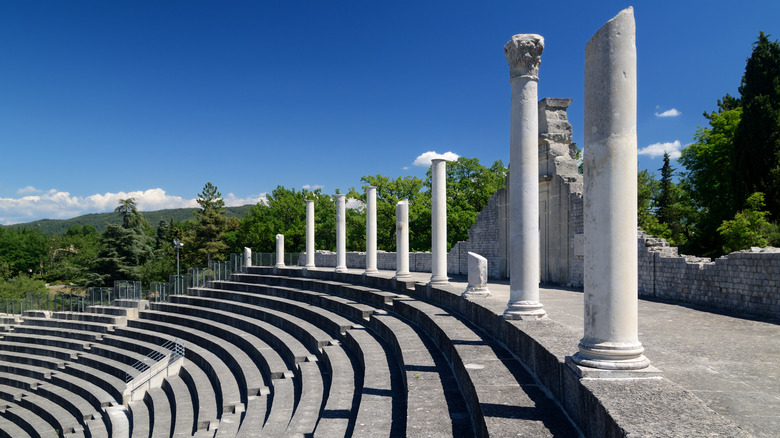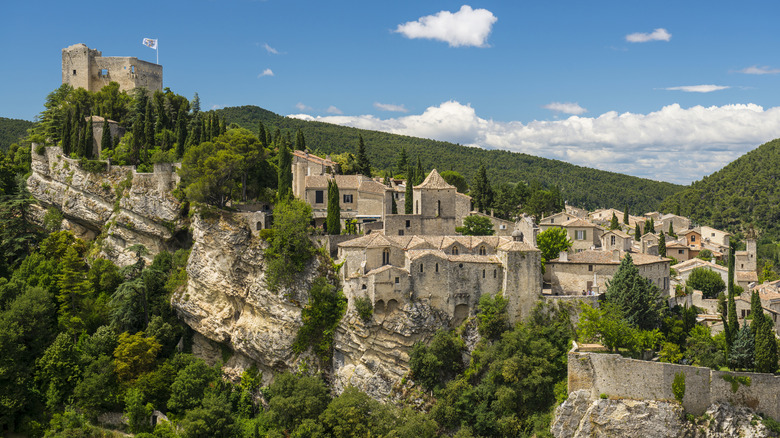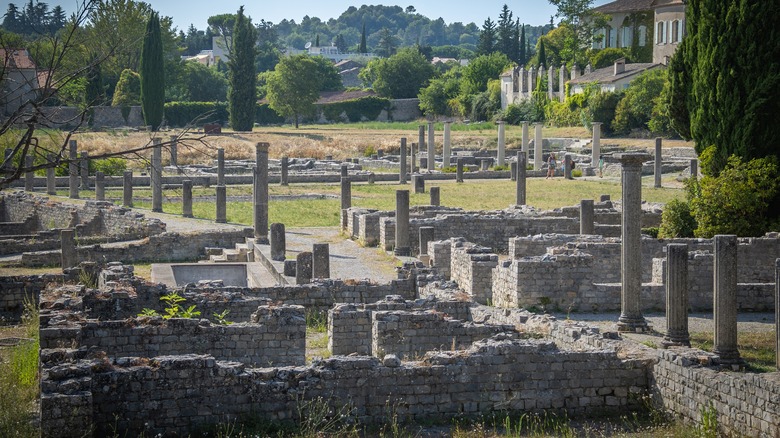The Southern Alps Of France Are Home To A Historic City Known For Its Preserved Roman Ruins
"What's in a name?" asks Juliet in one of the most famous Shakespeare soliloquies. In Vaison-la-Romaine, a town of approximately 8,000 people about 80 miles north of France's oldest and second-largest city, it's quite a lot — in fact, 2,000 years of history. The first part, Vaison, links back to its ancient origins as capital of the Gallic tribe of the Vocontii, who named it Vasio, after their goddess of springs. Over the subsequent centuries, that morphed with local dialect into Vaison, which it was called until the 1920s. At that time, archaeological excavations unearthed spectacular remains of its Roman past, which inspired the town to tack on "la Romaine" in recognition. The gambit worked, winning it a measure of fame that tourists still love today, including travel icon Rick Steves, who includes it on his Provence & French Riviera Itinerary.
Today, this history is splayed across two banks of the Ouvèze, the river that threads the village center and divides it into the upper town and the lower town. Thanks to its elevation, the first brings the best views and an evocative medieval atmosphere, especially thanks to the 12th-century castle at the peak. However, the lower town, which is much larger, is where most of the modern action occurs, including nearly all the restaurants, bars, markets, shops, as well as the cinema and theater. It is also where the Roman ruins are.
Upper town highlights
Begin any tour of Vaison-la-Romaine at the juncture of the upper and lower towns — a single-arch Roman bridge that has spanned the river since the first century. That it remains sturdy through 2,000 years of traffic, not to mention catastrophic floods in 1992, testifies to the engineering. From there, follow Rue du Pont as it swings west along the riverbank before swinging back along Rue de Horloge. The ambience cranks up with ragged stonework and greenery along the winding, cobbled paths. Follow your nose down the lanes and alleyways sprouting in different directions. There are no incorrect choices, as they all eventually reach the castle at the top.
The castle was established in 1195 by the count of Toulouse. The massive stone structure, with a square keep, dominates the town today as it did then. The castle's grounds provide panoramic views of Vaison-la-Romaine and the surrounding landscape. Another highlight is the 14th-century Belfry Tower part of a formerly fortified gate — portcullis, drawbridge, and all — that leads into the medieval town proper. The Cathedral of Saint Mary of the Assumption marks the third major sight of the upper town. Sitting atop a former rampart overlooking the valley, the 15th-century building sat abandoned through the 20th century before renovations reopened it.
Lower town highlights
Roman ruins remain the major attraction of the lower town. These largely stretch across the north side of Vaison-la-Romaine in two archaeological parks, Puymin and La Villasse. The first is home to the main attraction, a first-century Roman theater that held 6,000 spectators. Extensive restoration work put it back in action for festivals and concerts by performers like Radiohead and Mark Knopfler. Also in Puymin are the remains of private homes of the Roman elite and porticoed streets. Many of the artifacts discovered are on display at the Théo Desplans Archaeological Museum. On the other side of the Tourist Office is the La Villasse site, which continues to showcase ancient opulence with more manor houses, shops, baths, and fountains.
The "modern" area of Vaison-la-Romaine sits between the Roman and medieval. It's also a good place to sample the wine of the Côtes du Rhône Villages appellation at any number of wine bars, including L'Arbre à Vins and La Pause. A few sips may inspire a trip out to the wineries themselves, a short distance away. Several, such as Cave la Romaine, offer tours. Pair with cheese at Fromagerie Lou Canesteou or more provincial cuisine at restaurants like Manger & Cie and Bib Gourmand-awarded Les Maisons Du'O. Before going, though, perhaps bone up on the unspoken rules to dine like a local while you're in France. You may also bring them with you on the two-hour drive north from Vaison-la-Romaine to France's food capital.


